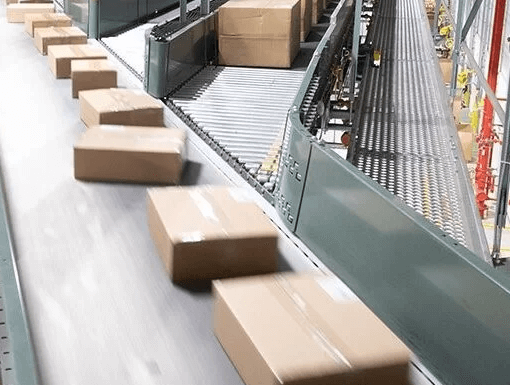When developing a concept for an automated warehouse and/or distribution center (DC), the focus around the central point of the design will always be product-related. Most, if not all of today’s modern automated systems, are required to transport, accumulate, and sort by some type of automated equipment that is flexible enough to handle multiple sizes and shaped product containers. Before any intelligent system design can be incorporated, these questions have to be discussed and confirmed.
How is my product being packed for shipment? Is the final shipped carton a requirement for the end-user or can that be modified to help design a more standardized automated system?
Keep in mind that it is very common to have many internal customers inside of a typical DC. The product being shipped may need to be transferred in many different packages.
- Corrugated cartons are the most common, but all sizes must be defined by size (H x W x L) and should relate to case weights.
- Reusable totes can also be a solution for wave/batch picking that may service a separate packing or value-added (VA) area that would require the product to be removed from the tote and transferred into a shipping carton. The tote parameters must also be defined.
- Bags can also be required to interact with the same processes throughout a typical distribution center.
Why are all these product definitions necessary for a simple accumulation system? Production rates and expectations drive the need to understand the product containers’ size and weight. Production rates can and will vary throughout a typical DC. Most system designers want to provide a system drawing that can meet the immediate rates and is flexible enough to provide a projected 5-year growth plan.
Accumulation Conveyor Applications:
There are several different types of accumulation conveyor techniques that should be considered when designing your automated system. Engineering formulas are used to determine the case feet requirements of each independent component, such as merging, induction methods or sortation. Case feet requirements are determined by case length, with or with air gaps.
Example: Pallet requiring 40 cases per pallet – Cases @ 20” long – This scenario would necessitate a conveyor that would use 24” zone lengths and would need to accumulate in place 40 cases before release. 20” x 40 cases = 800”/12 = 66.7’ would be the minimum linear case length of equipment needed. Typically, this distance represents 80% of the requisite conveyor length. This distance can vary based on the type of accumulation equipment wanted. For this application, the minimum conveyor length would be 80’.
- Light Pressure Live Roller – This type of equipment will allow cartons and totes to be nestled together for short periods of time with the conveyors still in a positive transportation mode. Care must be taken as the product must be stable and durable enough to allow for back-pressure caused by several cases to remain in a holding condition until the time of release.
- Light Pressure Accumulation – This type of equipment will allow for the product to accumulate for a longer period as the transportation pressure is reduced, which allows for cartons to remain engaged but with a much lower driving force. Cartons will still accumulate back to back without product damage. The line pressure developed from the accumulation of loads varies depending on factors such as size, shape, and weight of loads, but, in general, the line pressure exerted on the lead carton averages 4% to 6% of the total accumulated weight on the conveyor.
- Zero-Pressure Singulation Accumulation (ZPS) – This type of equipment is used when a more delicate product is used. Cartons that will not hold up to pressure without distortion or totes may create a “buckling” effect when too much pressure is applied. True ZPS equipment will allow the product to be set idle in a zone length that would also allow for air to be captured between cases. Using this equipment would increase the required case length distance as the efficiency drops by 15% due to air between accumulated products. This also results in higher conveyor speeds as cartons are released individually zone by zone causing the speed of the conveyor to be faster to achieve a higher rate.
- Zero-Pressure Slug Accumulation (ZPSL) – This type of equipment can be used when the product is more robust and will allow for product to accumulate in a back-to-back product queue. Then when queued product slugs are released the entire slug line will release simultaneously. This allows for a higher production rate to be discharged while running the conveyor at a slower speed.
Example 1: To calculate the minimum conveyor speed required for conveying 40 cpm with an average length of 18” using singulation release:
(40 cpm ´ 18² long) / 12² per ft. = 60 cfpm
From the chart 0-120 fpm is 50% efficient
(60 cfpm / 0.50 EFF) = 120 fpm
Example 2: To calculate the minimum conveyor speed required for conveying 40 cpm with an average length of 18” using slug style release:
(40 cpm ´ 18² long) / 12² per ft. = 60 cfpm
From the chart 0-120 fpm is 85% efficient
(60 cfpm / 0.85 EFF) = 70 fpm
Note: If an accumulation density of 100% cannot be achieved, multiply the actual or anticipated density by the percentage listed above to derive the appropriate release rate. Accumulation density is the total footage of a product over a length of the conveyor.
- Zero-Pressure Modified Slug Accumulation (ZPMSL) – This equipment operates the same as ZPSL, but the slugs can be separated by shorter bursts of product.
IE: The application requires 200 linear feet of product, but the downstream process can only take 10’ of case length at a time. Basically, the slug length would be 10’of back-back cartons then a gap before allowing the next 10’ of the back-back product during the release sequence. There are situations where it may be desirable to have both smart and singulation sensors in the same conveyor. An example is an accumulation conveyor taking a product from a high-speed sorter and delivering the product to the shipping dock. The accumulation conveyor must accept the product as fast as the sorter can divert it, but if that rate were maintained down to the loaders, they would be overwhelmed. Providing an accumulation conveyor with Smart Sensors will maximize the receiving efficiency of the conveyor. Inserting a section with singulation sensors or converting a few smart sensors to singulation sensors at the discharge end provides a means of gapping products and delivering it at a rate the person can control.






